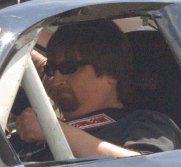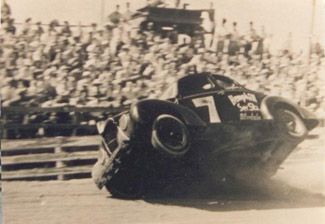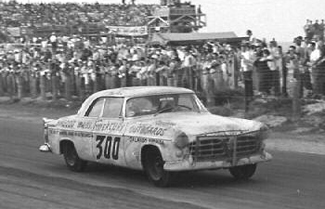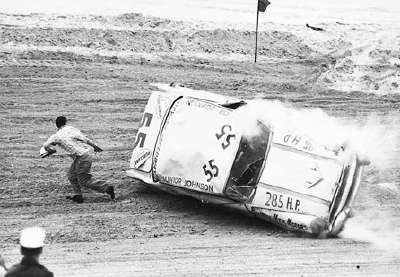
Brandon Reed
By Brandon Reed
Posted in Columns 1/28/11
With Speedweeks getting ready to kick in the next few weeks at Daytona, it brings to mind a simpler time, when, instead of fighting aerodynamics, drivers fought sand on their windshields.
From its inception, NASCAR’s premier venue was the old beach and road course in Daytona. It was, to say the least, an interesting place to race.
For many years, land speed records were attempted on the hard packed sands. When those attempts moved to the salt flats in Bonneville in 1935, stock car races were organized on a combination of the beach and the paved Highway A1A. Racers would run two miles south on A1A, make a sharp left onto the beach, then run two miles to the north before turning back onto A1A.
It was an incredible place, and generated some amazing races.
Not to mention some amazing stories.

Georgia's Lightnin' Lloyd Seay bicycles his car through the north turn at the beach en route to his only win there on Aug. 24, 1941.
Lloyd Seay, a Georgia moonshine runner, has been said by many to be one of the greatest natural talents to have ever climbed behind the wheel. Seay had a knack to bicycle his Ford on two wheels through the corners on the beach. The fans would clamor to see this incredible show put on by the Dawsonville native. Seay won on the beach on his fifth try on August 24, 1941. He started 15th on that day, but was in the lead by the time the first lap was over. He led every lap en route to the win.
Seay would die later that year at the hands of a family member in Dawsonville in an argument over sugar for moonshine.
Legendary driver Tim Flock is considered by many to be the best beach course racer of the NASCAR era. He was the only driver to win in every major NASCAR division to race on the beach, including Grand National, modified, and the convertible division.
Flock, who passed away in 1998, used to tell the story of racing on the beach in 1955 in his Carl Kiekhafer owned Chrysler 300. As he sprinted up the beach on the first lap, he ran into an unsuspecting flock of seagulls at about 140 miles an hour.

Tim Flock powers his way around a seagull-free beach and road course at Daytona in 1955.
The air was filled with enough feathers to make it look like a snowstorm had struck the beach.
“They started hitting my windshield, and the feathers and the guts stuck to my windshield!” Flock would say years later in an interview.
Leaning out the window, he used a rag intended to clean sand from his windshield to clear off the “bird remnants.” By the second lap, there wasn’t a seagull to be seen on the beach.
In 1956, legendary stock jockey Junior Johnson took a wild tumble on Daytona’s sands. Photos of the accident sequence shows Johnson exiting his overturned racer via the rear window before the car even came to a complete halt.

Junior Johnson makes a quick exit from his racer after a wreck on the beach in 1956. Legend has it that the car was still in motion when Johnson exited.
Two-time Cup champion Ned Jarrett had an equally close call in a beach race early in his career. He was racing up the beach in a modified/sportsman event when a faster modified hit him, sending his car tumbling into the surf. Dazed from the accident, Jarrett stumbled across the beach, miraculously evading being struck by oncoming racers, and promptly passed out upon reaching the spectator area.
Jarrett came too moments later in the arms of a rather rotund woman who was trying to pour whiskey from an Early Time liquor bottle into his mouth to try to revive him.
“I was bleeding, and I was pretty sure I was going to die,” said Jarrett years later. “I just knew they wouldn’t let me into heaven with that liquor on my breath!”
Racing on the beach came to an end after the 1958 Grand National event, which was won by Paul Goldsmith. The next year, drivers traveled a little further down A1A to the new Daytona International Speedway, which held its first events the following year.
As NASCAR gets ready for the latest edition of Speedweeks at Daytona, it should be remembered that the events would be nothing like they are today if it wasn’t for the pioneers who weren’t afraid of high speeds during low tide.
Brandon Reed is the editor and webmaster of Georgia Racing History.com.
Questions, comments, suggestions? Email us!
This website is not affiliated with or endorsed by the Georgia Racing Hall of Fame or the Georgia Auto Racing Hall of Fame Association, Inc. All content is the intellectual property of the individual authors. All opinions are those of the individual authors. Please do not repost images or text without permission.
